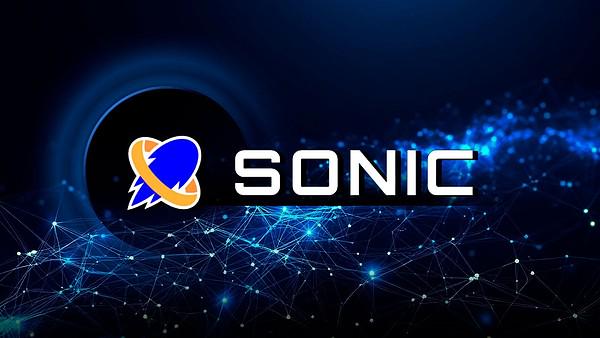
1. Project Overview
1.1 Project Basic Information
Sonic SVM is the first SVM (Solana Virtual Machine) Layer 2 network expansion project based on the Solana blockchain, focusing on optimizing games and high-frequency interactive applications. The project's vision is to expand Solana's infrastructure based on the HyperGrid architecture, providing game developers with a high-performance, low-cost blockchain environment to support large-scale online games and applications, meeting the growing demand of Web3 users.
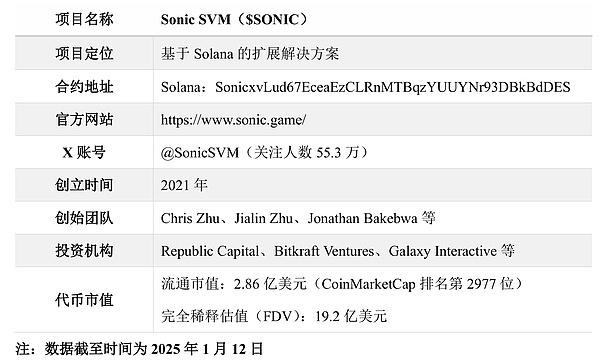
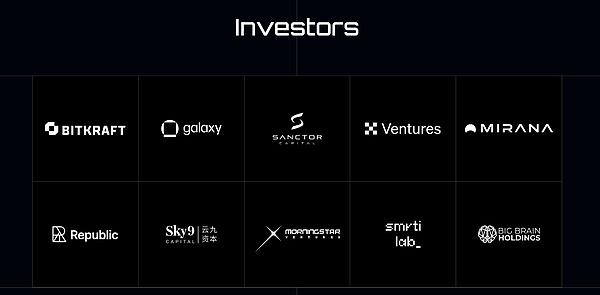
1.2 Project Development History
2023: The core team of the project completed its initial formation, and technical research and development officially began, focusing on the design of the Sonic HyperGrid framework, which was gradually improved after multiple rounds of technical validation.
March 2024: The Sonic SVM white paper was released, detailing the architecture and mechanisms of Sonic SVM, laying a theoretical foundation for the project's development.
June 2024: Completed a $12 million financing round, led by Bitkraft, with participation from Galaxy Interactive, Big Brain Holdings, Morningstar Ventures, etc., providing financial support for the project's further development.
June 2024: Launched the testnet, beginning to attract developers and users to participate in testing, verifying the project's performance and stability. Accumulated over 100,000 wallet addresses within a week.
January 2025: The $SONIC token was officially generated (TGE) and simultaneously listed on well-known trading platforms such as OKX, Bybit, Bitget, KuCoin.
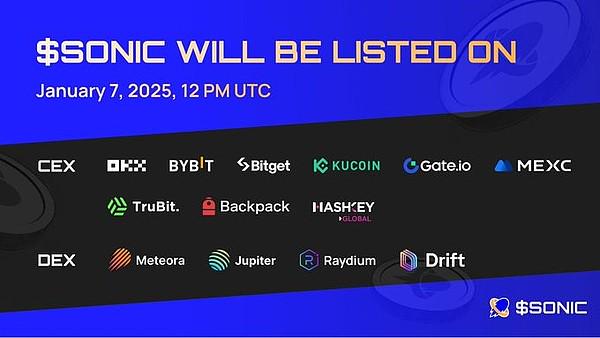
1.3 Core Team Background
The core team of Sonic SVM is very young, with key founders originating from rct AI, including:
Chris Zhu, CEO, graduated from NYU Stern School of Business in 2020, previously worked at ByteDance and rct AI, and founded Mirror World (the predecessor of Sonic) in September 2021.
Jialin Zhu, Chief Product Officer, graduated from The Chinese University of Hong Kong in 2021, previously worked at rct AI, and co-founded Mirror World in 2021.
Jonathan Bakebwa, CTO, graduated from Beijing Institute of Technology in 2020, previously worked at rct AI and founded Xtellar Works, co-founded Mirror World in 2021.
Yutong Li, Head of Finance/Legal/Human Resources, graduated from the University of New South Wales in 2021, interned at several consulting firms such as Accenture and BCG, as well as internet companies like ByteDance and Alibaba, joined Mirror World in February 2022, previously served as Product Manager.
Arif Kazi, Head of Business, graduated from BSE Institute Ltd in 2021, previously worked at mesha, Stader Labs, DappLooker, joined Sonic in October 2023.
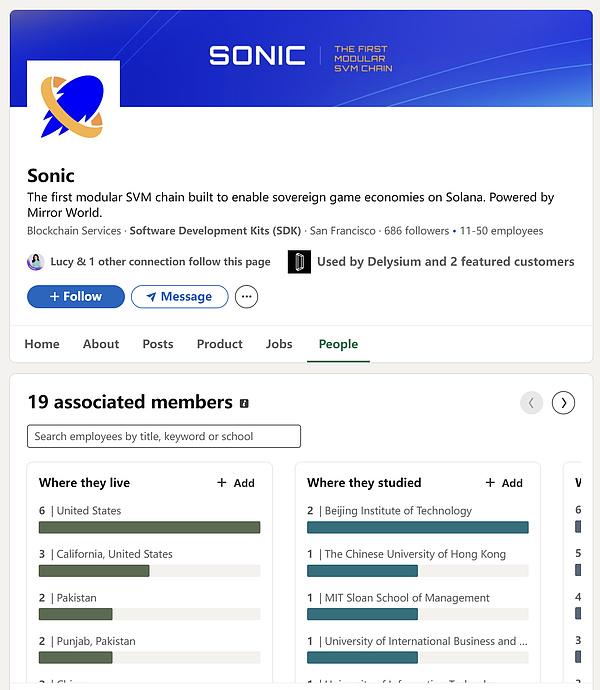
2. Business Model
2.1 Technical Logic
Sonic SVM revolves around HyperGrid technology, achieving distributed operation of games and DApps by constructing a multi-grid architecture (Grids).
HyperGrid is a parallel processing framework that enhances Solana's infrastructure. The design intent of HyperGrid is to achieve high customization and scalability while maintaining native composability with Solana. Applications supported by HyperGrid can be written on EVM but ultimately executed on Solana, with the final settlement layer being Solana, facilitating the application of the EVM ecosystem on the Solana chain. This differs from the direction of MoveVM technology with Ethereum as the final settlement layer.
Grids aim to allow a large number of DApps to run on HyperGrid, reducing the impact on Solana L1 performance and minimizing performance interference between DApps. With the support of the HyperGrid architecture, DApp developers can choose to use the HyperGrid public grid according to their needs or horizontally scale to create their own dedicated grid. The choice depends entirely on the developers' assessment of performance and cost. Additionally, DApp developers can also shut down the grids they create without affecting other grids, as the validation, recording, and reading of transactions and state changes generated by each grid are ultimately completed independently through the connection between HyperGrid and Solana L1.
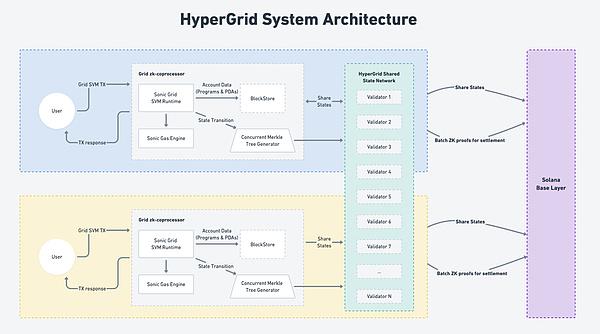
2.2 Staking and Validator Network
The HyperGrid ecosystem adopts a staking protocol, where validators need to stake $SOL as collateral to participate in the network. This staking mechanism is not merely a passive locking of funds but an active commitment to ensure the security and continuity of all grids within HyperGrid. Echoing the re-staking concept of EigenLayer, the collective staking pool serves as the underlying security guarantee for the entire HyperGrid system.
Validators in HyperGrid take on multiple roles, not just producing blocks. Their responsibilities include:
Ø Transaction Sequencing: Validators sort transactions from the grids, ensuring order and consistency in the processing flow.
Ø Slot Proposal: As network facilitators, validators propose slots (equivalent to blocks) to each grid. This can be seen as outsourcing execution, where the grid is responsible for the computation of state transitions.
Ø Execution Verification: After execution, validators verify whether the results match the expected state transitions. This step is crucial for maintaining the integrity of the ledger.
Ø State Commitment: After successful verification, validators are responsible for publishing the verified state transitions to the Solana mainnet.
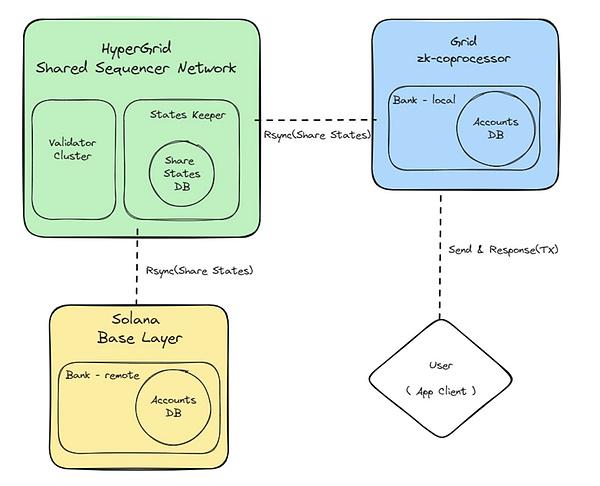
2.3 Incentive Model
Delegating a series of actions to validators is crucial for maintaining a trustless and decentralized environment, ensuring that no single entity can exert undue influence over the network.
To recognize the critical role of validators, they are rewarded with HyperGrid tokens for the services they provide. This incentive model aims to encourage honest participation and curb malicious behavior. The reward structure, including detailed numbers and equations, is planned to be adjusted through an iterative development process. It will be calibrated based on the network's performance and security needs, ensuring that the interests of validators are closely aligned with the health and success of the HyperGrid ecosystem.
Starting a validator requires the operator to stake 100 SOL tokens. Once established, validators become eligible to receive votes from other users. These users participate by purchasing SONIC tokens, which are then locked to convert into $veSonic. By staking their $veSonic tokens with validators, users can share in the rewards generated by the validators. These rewards are then distributed between the validators and users who staked tokens, creating a symbiotic relationship within the system that encourages participation and investment in the network's health and growth.
In the HyperGrid ecosystem, validators also share the responsibility of shared sequencers, so L2 platforms built on HyperGrid will prioritize these shared sequencers among validators. As part of their compensation, validators will receive a portion of the sequencing fees, which helps to increase their revenue stream.
Additionally, the system incorporates observer nodes responsible for verifying the accuracy of transactions conducted on various L2s. As a key component in ensuring system security, these observer nodes play a crucial role in detecting any centralized malicious activities that may trigger a slashing mechanism. For their monitoring work, these nodes will be rewarded with SONIC tokens.
Holding $veSonic represents capturing value within the ecosystem, such as a portion of embedded exchange fees, NFT market transaction fees, and a share of launchpad revenue. This reflects the intrinsic value proposition of $veSonic. Furthermore, as recognition for contributions to the ecosystem, $veSonic holders are eligible for additional ecosystem rewards. Prioritizing $veSonic holders, future games launched on HyperGrid will provide rewards for them, allowing users to choose the game rewards they wish to receive, thereby enhancing interactivity and engagement within the ecosystem.
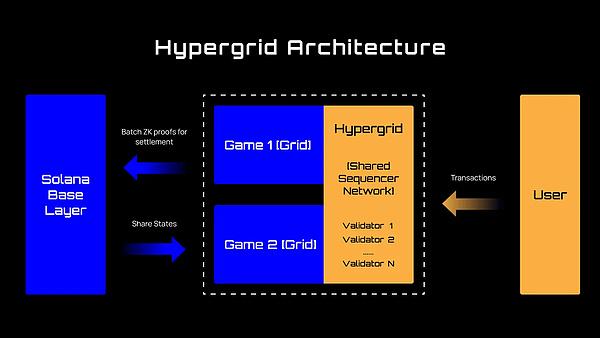
4. Token Economics
The native token of Sonic SVM is $SONIC, with a total supply of 2.4 billion tokens and an initial circulation of 15%. The specific distribution is as follows:
Ø Community: 57% allocated to the community, including ecosystem and community development (30%), initial claims (7%), and HyperGrid rewards (20%).
Ø Early Supporters: 8% allocated to early supporters, with these tokens starting to unlock linearly after 12 months, continuing for 24 months.
Ø Investors: 15% allocated to investors, with these tokens starting to unlock linearly after 12 months, continuing for 24 months.
Ø Foundation: 20% allocated to the foundation, including team members and advisors, with these tokens starting to unlock linearly after 18 months, continuing for 36 months.
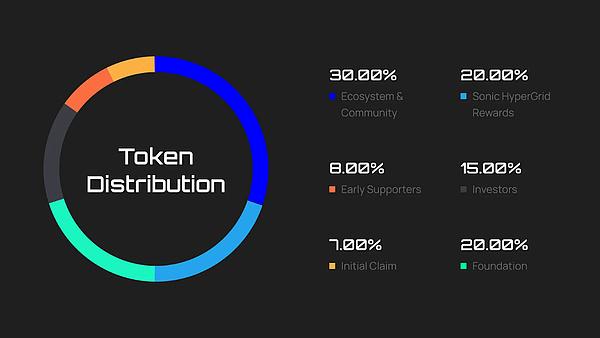
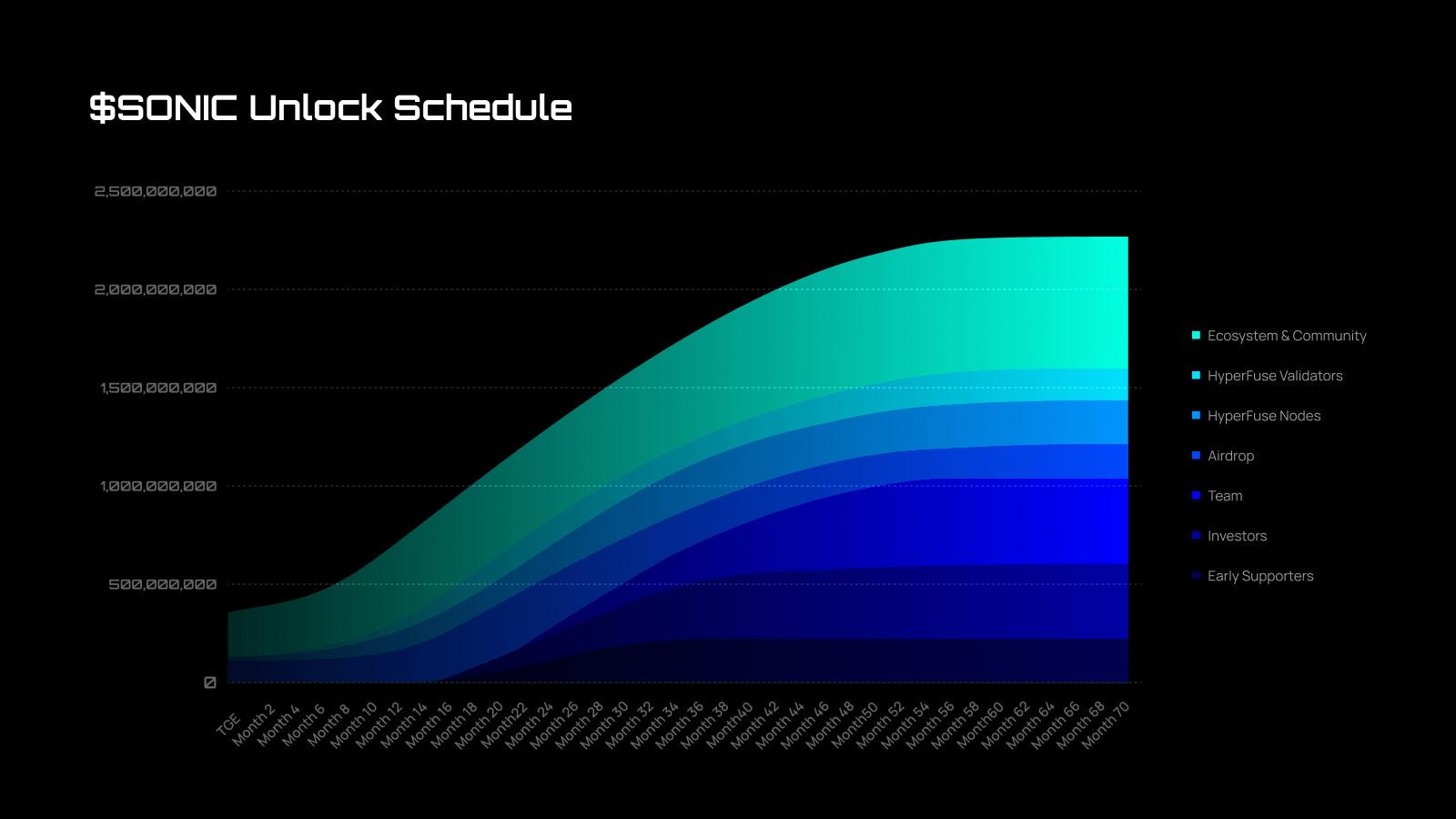
Main uses of the token:
Ø Payment Tool: $SONIC can be used to pay for in-game assets, NFTs, and other application services.
Ø Staking and Rewards: Users and validators earn network rewards by staking $SONIC.
Ø Governance Voting: Token holders can participate in key network decisions, including funding for new projects and proposals for network upgrades.
Ø Incentive Mechanism: Supports developers and users in earning token rewards by participating in ecosystem activities.
3. Project Prospects
1. Industry Analysis
Blockchain technology provides new opportunities for game developers, such as digital asset ownership, decentralized economies, and community governance. The blockchain gaming and decentralized application industry is rapidly rising. According to data analysis, the global blockchain gaming market is expected to reach $30 billion by 2025. The number of Web3 game users is also growing at a rate of 50% per year. However, scalability remains one of the main challenges facing Web3 games.
Users have a strong demand for high-performance, low-cost gaming experiences, especially in high-frequency interaction and real-time response application scenarios. Developers need a blockchain platform that can support a large number of users and high throughput to build and operate successful Web3 games.
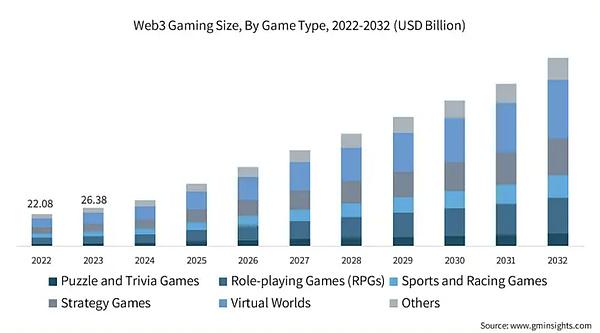
With continuous technological advancements and market maturation, Web3 games are expected to become an important part of the mainstream gaming market. However, currently, most mainstream Web3 games are deployed on Polygon, BNB, and ETH chains; none of the top 25 UAW games run on Solana, and similarly, none of the top 10 market cap games originated on Solana. Therefore, Sonic SVM, with its high performance and low latency features, is expected to occupy an important position in this market and promote the large-scale adoption of Web3 games.
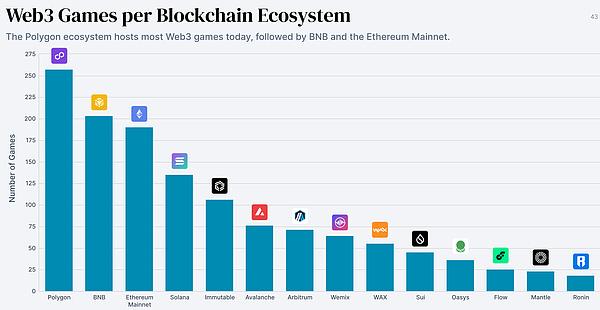
2. Ecosystem Construction
As a project born for Web3 games, Sonic SVM closely collaborates with game studios, providing not only technical support but also jointly conducting marketing activities. For example, the first AAA title launched in collaboration with the well-known game studio 343 Industries achieved over 100,000 downloads at launch, with both parties deeply binding their interests through revenue sharing and joint NFT issuance, with in-game NFT sales exceeding $500,000 on the first day. Additionally, partnerships with social media platforms like TikTok have brought massive traffic to the ecosystem, achieving exponential user growth and retention through creative challenges and influencer promotions, with over 5 million participants in the challenge and more than 2 million new users brought in through influencer promotions.
In terms of community building, Sonic SVM has established an active community governance mechanism, allowing $SONIC token holders to participate in project decisions, including protocol upgrades, fee adjustments, and the direction of ecosystem fund usage. Regular community AMA (Ask Me Anything) events are held at least twice a month to bridge the gap between the team and users, collect feedback, and optimize the project development path in a timely manner, with over 80% of community suggestions receiving effective responses and implementations.
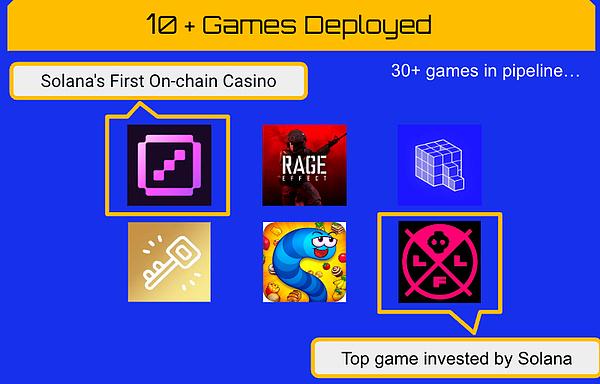
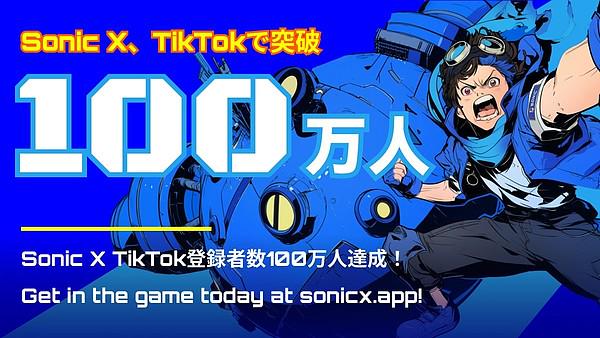
3. Development Plan
According to the roadmap published by Sonic SVM, the development plan is as follows:
(1) Phase One: Network Genesis (Q4 2024 to Q1 2025)
Ø HyperGrid Network Genesis: Launch the HyperGrid shared state network to support the creation of interconnected SVM networks, achieving seamless interoperability.
Ø Sonic SVM Genesis: Official launch of the Sonic SVM network, laying the foundation for scalable on-chain games.
Ø HyperFuse Network Security: Deploy decentralized node clusters to ensure the security and accuracy of HyperGrid.
Ø $SONIC TGE: Complete the token generation event for $SONIC, unlocking its full ecosystem potential.
(2) Phase Two: Mainnet Alpha Launch (Q1 2025)
Ø Sonic Mainnet-Alpha: Official launch of the Alpha version of the Sonic SVM mainnet, including key services such as bridging, decentralized exchanges, oracles, and NFT programs.
Ø Sonic X - TikTok App Layer: Launch native Android and iOS applications to support high-quality game and digital asset distribution.
Ø Sonic Bridge: Integrate the official token bridge to support assets such as SOL, sSOL, sonicSOL, and stablecoins (USDC/T).
Ø HSSN Validator Onboarding: Activate HSSN validators to ensure network security and operation.
(3) Phase Three: Ecosystem Expansion (Q2 2025)
Ø HyperGrid Optimistic Rollup Stack: Integrate new SVM into the HyperGrid Op-Rollup stack to enhance network scalability.
Ø Grid v2 Deployment: Launch the Sonic Grid v2 testnet and plan integration into the mainnet to improve network performance.
Ø $SONIC Staking & Rewards: Introduce $SONIC staking and reward programs, allowing holders to earn rewards through HSSN validators and implementing penalty mechanisms to ensure network security.
Ø RUSH ECS Growth: Expand the RUSH ECS framework to support more on-chain games with SDK clients.
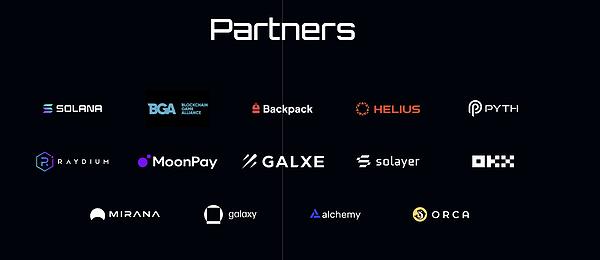
4. Competitors
Sonic SVM is the first expansion solution targeting games on Solana. Similar projects include other Layer 2 solutions and blockchain platforms specifically for games, such as Immutable X and WAX.
(1) Immutable X
A Layer 2 solution on Ethereum specifically for NFTs, which has attracted several well-known game projects, such as Gods Unchained. Immutable X has gained market recognition due to its high performance and low fees.
(2) WAX
WAX is a blockchain platform focused on games and NFTs, which has established a rich ecosystem supporting multiple games and applications. WAX attracts a large number of users through its efficient transaction processing capabilities and low fees.
Compared to similar competitors, Sonic SVM's Layer 2 solution, relying on Solana's high TPS (theoretical peak exceeding 60,000 TPS), ensures transaction confirmations in seconds, with average fees as low as $0.5, providing users with a smooth and low-cost interaction experience, far exceeding the transaction efficiency of most competitors on public chains. Additionally, through partnerships with mainstream social platforms like TikTok, Sonic SVM has a massive potential user base, offering broader audience reach and greater user growth potential compared to promotions limited to crypto-native communities.

5. Investment Potential
Sonic SVM, with its unique technical architecture, innovative business model, and forward-looking ecological layout, has opened up a brand new track. Since the project's launch, it has demonstrated strong development momentum through a series of breakthroughs at key nodes. With its high performance and low latency features, Sonic SVM is expected to occupy an important position in the Web3 gaming market.
In terms of token usage, $SONIC, as the native token of the Sonic SVM ecosystem, has a wide range of use cases. From the perspective of token distribution and unlocking rhythm, the allocation ratio is relatively reasonable, but a large number of tokens will be unlocked after 12 months, creating significant uncertainty about whether Sonic SVM's development can meet the established expectations at that time.
Overall, the most important investment story for Sonic SVM still lies in the traffic from platforms like TikTok (it is worth mentioning that the founder of Sonic SVM worked at ByteDance for 2 years, but held a relatively low position, raising questions about the extent to which resources can be connected). If it can successfully achieve large-scale breakout, the valuation of the $SONIC token could have at least a tenfold upside from its current level, making it worth a small position bet on the upward probability; however, if it fails to attract a large number of Web2 users as expected, combined with the uncertainty of the Solana network in the Web3 gaming market, the story of Sonic SVM may also struggle to continue.
In summary, it is recommended to consider investments in $SONIC with caution.
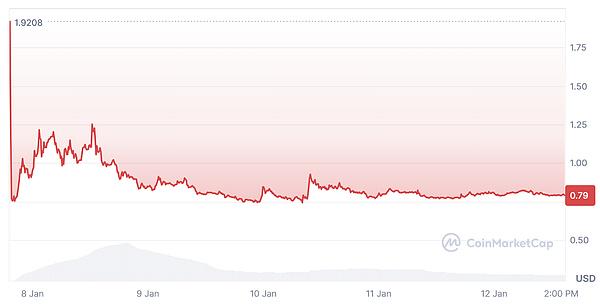
4. Conclusion
As a new Layer 2 solution in the Solana ecosystem, Sonic SVM provides a high-performance, low-cost blockchain environment for games and high-frequency applications through its innovative technical architecture and customized features. Its collaboration with TikTok and successful market performance further demonstrate its strong ability to attract users and developers. With the continuous expansion of the ecosystem and ongoing technical optimization, Sonic SVM has the potential to achieve greater breakthroughs in the Web3 field, promoting the large-scale adoption of Web3 games.
For investors with a higher risk appetite who are optimistic about the long-term development of Web3 games and applications, it is advisable to closely monitor technological and ecological progress and consider accumulating a small amount of $SONIC at lower prices to bet on the project's potential to become a breakout product; conservative investors are advised to take a wait-and-see approach, waiting for the market to mature and project uncertainties to decrease before making decisions.
免责声明:本文章仅代表作者个人观点,不代表本平台的立场和观点。本文章仅供信息分享,不构成对任何人的任何投资建议。用户与作者之间的任何争议,与本平台无关。如网页中刊载的文章或图片涉及侵权,请提供相关的权利证明和身份证明发送邮件到support@aicoin.com,本平台相关工作人员将会进行核查。




